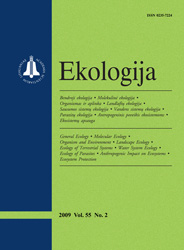 ISSN 0235-7224 ISSN 2029-0586 (online) |
2010 m. Nr. 3-4 Effect of long-term industrial pollution on microorganisms in soil of deciduous forests situated along a pollution gradient next to a fertilizer factory. 3. Species diversity and community structure of soil fungi
The present study was conducted to establish whether a long-term (57 years) chemical industry pollution could influence fungal community structure in deciduous forest soil. This paper presents results of two-year investigations of soil fungi in seven deciduous forest plots located at a different distance (0.7–15 km) from the emission source (ES) – a fertilizer factory in Central Lithuania. Fungal abundance as colony forming units (CFUs) was determined by the plate dilution technique, and the identification of fungi to a species was based of their micro- and macromorphology. Their abundance varied from 0.88 to 2.59 thousand CFU g–1 dry weight soil and was significantly negatively correlated with the distance from the ES (Spearman’s correlation rs = – 0.78). Phosphorus and humus content was the major factor to influence the fungal abundance (rs = 0.88 and 0.79, respectively). Copper and lead were the two pollutants (out of Cu, Cd, Ni, Pb, Zn and As investigated), which exerted a significant impact on the community structure. In total, 158 species out of 11 394 isolates were identified. Most of the isolates belonged to Anamorphic (Mitosporic) fungi (74.87% of the total CFU), followed by Zygomycetes (15.56%), Ascomycetes (7.78%), with only 3 isolates from Basidiomycetes. The majority of fungi (33.22%) were from the genus Penicillium, followed by Trichoderma (6.98%) and Paecilomyces (6.58%). Keywords: forest soil, fungi, fungal communities, abundance, species diversity, pollution impact, heavy metals |
Issues:
2011 - Vol.57 No. 1, No. 2 2010 - Vol.56 No. 1-2, No. 3-4 2009 - Vol.55 No. 1, No. 2, No. 3-4 2008 - Vol.54 No. 1, No. 2, No. 3, No. 4 2007 - Vol.53 No. 1, No. 2, No. 2.priedas, No. 3, No. 4 2006 No. 1, No. 2, No. 3, No. 4 2005 No. 1, No. 2, No. 3, No. 4 2004 No. 1, No. 2, No. 3, No. 4 2003 No. 1, No. 2, No. 3, No. 4 2002 No. 1, No. 2, No. 3, No. 4 2001 No. 1, No. 2, No. 3, No. 4 |